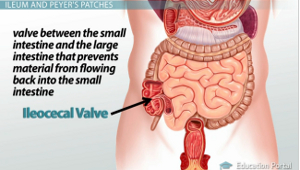Problems w/ constipation? Diarrhea? Having Strong urges to Defecate but Not Successful? Bloating? Irritable Bowel Syndrome? Dark circles under your eyes? Sudden low back pain after bending over to pick up a dime on the floor? Pelvic Pains? Joint pains? Weakness of the Psoas, Iliacus or Quadriceps muscles – muscles involved in posture and locomotion
Could it be your Ileo-Cecal Valve (or your Houston’s valve) is involved?
The Ileo-Cecal Valve is located between the ileum (last portion of your small intestine) and the cecum or ascending colon (first portion of your large intestine; the appendix lays just below it.. Its function is to allow digested food materials to pass from the small intestine into your large intestine. The ileo-cecal valve also blocks these waste materials from backing back up into your small intestine. It is intended to be a one-way valve, only opening up to allow the digested material to pass through and then closing to prevent the fecal contents from “falling” back into the small intestine. When the small intestine/large intestine is not active in the process of digestion or stool production), the valve is relaxed, neither open or closed.
Houston’s Valve – are transverse folds of rectum tissue that supports the weight of your feces and prevents pressure on the anal tissue to prevent a constant sense of urgency to defecate. A problem with the Houston’s valve can create a constant urge to defecate however the person may not be successful or have an incomplete defecation.
Ileocecal Valve Syndrome
When the ileocecal valve is stuck open waste products can back up into the small intestine (much like a backed up kitchen sink drain) disturbing your digestion and also creating unhealthy toxins that are absorbed into the body. Also, if the ileocecal valve is stuck closed waste products are prevented or constricted from passing into the large intestine.
Unfortunately, this disorder is often overlooked by the medical profession. A dysfunctional ileocecal valve can result in a combination of symptoms.

Ileo-Cecal Valve (or Houston’s Valve)Syndrome Signs & Symptoms
Dark circles under eyes
Bowel disturbances (diarrhea / constipation)
Constant sense of urgency to defecate however either unsuccessful or incomplete.
Weakness of the Psoas, Iliacus or Quadriceps muscles – muscles involved in posture and locomotion
Low back pain – esp. pain on bending over
Severe lumbar disc complaints (sharp sudden pain)
Sinus problems, post nasal drip, headaches, tinnitus
GERD symptoms
Joint pains
Pelvic congestion and pain
PMS
Chronic inflammatory or toxicity complaints.
Causes of Ileo-Cecal Valve Syndrome
HCl Deficiency – Major Cause: Antacid Medication for GERD/H. Pylori – stops via various ways the flow of stomach acid needed to digest food, and absorb certain B vitamins and Calcuim.
Dehydration
Emotional upsets
High Colonics
How you eat (eating too quickly, eating foods you are sensitive to, under-chewing your food)
Foods you eat (carbonated drinks, alcohol, caffeine, chocolate, raw foods, hot spicy foods)
TMJ Disorders
Treating Ileo- Cecal Valve (or Houston’s) Syndrome
Treatment options for ileocecal valve (or Houston’s) syndrome are adjustment of the value itself, chiropractic adjustment of the spinal segmental that innervates the value, and the small intestine, large intestine and the rectal neurovascular & neurolympathic pts for the valves and the small & large intestine,and rectum and a change in diet.
Please note that adjustment of the valve MUST BE DONE IN ORDER TO “FIX”THE PROBLEM; just doing the other techniques will not “fix” the problem.
Possible nutrition: Chlorophyll, digestive enzymes, Vitamin D, Calcium
Temporary Diet Recommendations During Treatment
Avoid for two weeks:
Roughage foods–such as: seeds, whole grains, raw vegetables
Spicy foods–such as: chili powder, hot peppers, salsas, black and cayenne pepper,
Also eliminate– liquors, alcoholic drinks, cocoa, chocolate, caffeine products
References for your information:
A) on the Ileo-cecal Valve:
http://education.yahoo.com/reference/gray/subjects/subject/249
http://depts.washington.edu/growing/Assess/SBS.htm
http://www.anatomyatlases.org/atlasofanatomy/plate37/06cecumappendix.shtml
http://depts.washington.edu/growing/Assess/SBS.htm
http://findarticles.com/p/articles/mi_m0FDL/is_2_12/ai_n17209639/ -(Iliocecal valve syndrome and its role in GI disorders)
B) On how a problem in visceral can “refer” pain to the back (for example)
Muscles, Connective Tissue Between Organs Influence Illness
http://www.webmanmed.com/spinalnrv_files/lumbar.html
www.instantanatomy.net/abdomen/muscles/iliacus.html
http://www.instantanatomy.net/abdomen/nerves/referredpain.html
http://depts.washington.edu/msatlas/images/201.jpg -picture of iliopsoas muscle – note how part of the muscle’s insertion is into the lumbar spine..unequal pull or inflammation due to referred pain on one side will cause low back pain
C) On Houston’s Valve: http://en.wikipedia.org/wiki/Transverse_folds_of_rectum
© Revised: 2012-Dr.Vittoria Repetto
Muscles, Connective Tissue Between Organs Influence Illness
Want more information on Dr. Vittoria Repetto and her NYC Applied Kinesiology/Chiropractic/ NKT practice at 230 W 13th St., NYC 10011; please go to www.drvittoriarepetto.com
And please check out the Patient Testimonials page on my web site.
Want to be in the know on holistic information and postings?
https://www.facebook.com/wvillagechiropracticappliedkinesiologynkt/
Or join me at Twitter: www.twitter.com/DrVRepetto
Pingback: Tweets that mention What is an Ileo-Cecal Valve and how is it related to your digestive health? « Dr. Vittoria Repetto's Blog -- Topsy.com
In good time for your blog, it’s just what I wanted. Keep working hard to come great results. You’re too big.
LikeLike
Thanks
LikeLike
Pingback: Chronic Inflammation and How Chiropractic & Applied Kinesiology Can Help. | Dr. Vittoria Repetto's Blog: